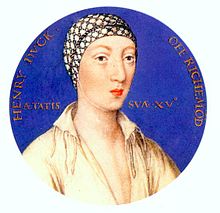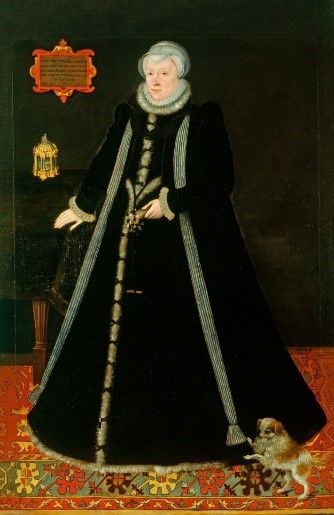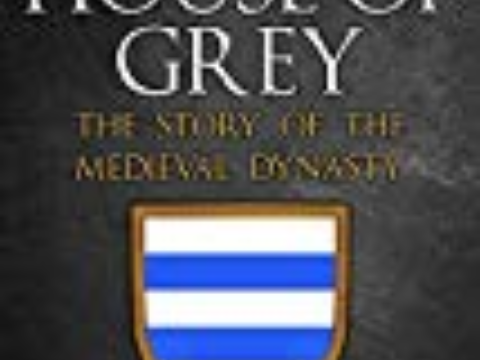The Tudor Succession Problem
Chapter 4 : Henry VIII
Henry VIII is notorious for his matrimonial history. Six wives and two known mistresses, but only four children and no grand-children to show for it. What went wrong?
Within a few weeks of becoming king, Henry married his brother’s widow, Katharine of Aragon. The match had been planned since not long after Arthur’s death, but not completed, partly because of Henry’s youth, and partly because Henry VII and Katharine’s father could not agree over the financial settlements.
The newly-married couple were crowned together on 29th June 1509 and swiftly showed that they knew their duty. Katharine was pregnant almost immediately and expected to deliver her first child in March 1510. In January 1510 she miscarried. Such an event was disappointing, but not unusual. Katharine fell pregnant again and carried the child to term. To the great delight of King, Queen and country, a prince was born on 1st January 1511, and celebrated with the greatest tournament of Henry’s whole reign. Heartbreakingly, Henry, Duke of Cornwall died within two months.
Henry’s heir was therefore still his sister, Margaret, Queen of Scots. There does not seem to have been much love lost between the siblings, and Henry had conceived a great animosity against her husband, James IV. Kings of Scots and England were always at odds, but for Henry it seems to have been personal, although the two never met. Margaret and James however, had had no more luck than Henry and Katharine. They had lost three sons by this time and had no heirs other than James’ cousin, the Duke of Albany, who was exiled in France. The Scottish couple’s luck turned the following year, and Margaret gave birth to a boy, James, who lived.
Despite having no immediate heir, Henry decided to prosecute his war in France personally in 1513. Had he died on campaign, if Margaret’s claim were rejected (which is likely, as the English would have been unhappy with a Scottish king, and there would have been no idea that Margaret would rule alone – she was bound to be controlled by her husband) the next heir was Henry’s cousin, Henry Courtenay, Earl of Devon. Devon was the son of Elizabeth of York’s sister, Katherine.
Happily, Henry did not die on campaign, but his rival, James IV, was killed at Flodden, leaving an eighteen month old heir, now James V, and a pregnant wife. This little boy was still Henry’s closest male relative.
In the years following 1511, Katharine of Aragon had at least one, possibly two, failed pregnancies, before, in February 1516 she and Henry finally produced a child who would live. There was much rejoicing, but disappointment at the child’s female gender. In 1518, another stillborn daughter completed the sad tale of Katharine’s pregnancies.
Henry was clearly feeling somewhat shaken by his failure to produce a male heir. Although any faults in the health or gender of children were usually blamed on the woman, Henry at various points seems to have questioned his masculinity. In 1519, however, his prayers were answered when he had a son. The only problem was, that he was not married to the boy’s mother.
Fears for the succession began to grow. In 1521, Edward, 3rd Duke of Buckingham, was executed for treason. Buckingham was another descendant of Edward III, and was rumoured to have said that, in the event of Henry’s death, he ought to be king. Buckingham had also married his oldest son, another Henry, to Ursula Pole, who was the daughter of Margaret, Countess of Salisbury, creating a rather worrying concentration of royal blood. Still, lopping off Buckingham’s head, disinheriting his children and sending Margaret of Salisbury’s son to the Tower for while would put a stop to claims from that quarter.
Time passed, and by 1524 it was clear that there would be no more children for Henry and Katharine. Henry was faced with a terrible dilemma. If he accepted his daughter, Mary, as his heir, it would be the first time since 1135 that a woman was named as heir to the throne. It hadn’t turned out well back in the twelfth century.
But times had changed, and since the 1100s there had been a few queens, and many more female regents in Europe who had ruled competently. Not far to look was Mary’s own grand-mother, Isabella of Castile, one of the most successful of all mediaeval monarchs, or the extremely capable Marguerite of Austria, Regent of the Netherlands first for her father, the Emperor Maximilian, then for her nephew, Emperor Charles V. The problem was that Mary would marry, and her husband, even if he did not take the Crown, would be introducing his bloodline, to replace Henry’s.
Mary herself was an intelligent and attractive child, so Henry decided to test the waters by setting her up in fact, although never in name, as Princess of Wales. She was sent to Ludlow in 1525 to preside over the Council of Wales, as her uncle Arthur, and her great-uncle, later Edward V, had done. Sometime previously, she had been betrothed to her cousin, the Emperor. Perhaps to have an Empress as Queen of England would not be so bad…although that hadn’t helped in 1135 either!

Henry had another string to his bow – his illegitimate son, Henry Fitzroy. He decided to bring the boy forward from relative obscurity, give him royal titles and a household fit for a King’s son to see if that would be a better option than a daughter. Fitzroy was duly created Duke of Richmond and Somerset (titles last held by Henry VII who had been Earl of Richmond, and the little brother of Henry VIII’s who had died in 1500) and sent north as Lord President of the Council of the North.
Neither of the alternatives he had was really attractive to Henry, and the third possibility, his nephew, James V of Scotland, was his worst nightmare. During James’ minority, Henry had made efforts to bring Scotland under the control of England. Whilst there were many in Scotland who were inclined to alliance with their southern neighbour, Henry’s high-handed interference, and rumours that he intended to kidnap his nephew had soured relations irretrievably. Queen Margaret was eager to see a rapprochement between her son and her brother, and a marriage between James and Princess Mary was mooted at various times, but never pursued.
Queen Margaret also had a daughter, Lady Margaret Douglas, by her failed second marriage to Archibald Douglas, Earl of Angus. This daughter, the same age as her cousin Mary, was, in 1524, either in one of the Douglas castles, or possibly in exile in France with her father. In 1528 the marriage between Margaret and Angus was annulled, on the basis that he had been pre-contracted to marry another woman. Whilst Lady Margaret’s legitimacy was confirmed as it was generally accepted that children of a marriage contracted in good faith were legitimate, even if the marriage was subsequently annulled, the annulment cast a shadow over her position.

There was also the possibility of heirs through the line of Henry’s younger sister, Mary, the French Queen. After a state marriage to Louis XII of France in 1514, Mary had married Charles Brandon, Duke of Suffolk, a match that was generally considered to be far beneath her dignity, Brandon being the son of a mere gentleman, and only promoted to a Dukedom because he was Henry’s closest friend.
By 1525, the Suffolks had three living children, Henry, Earl of Lincoln (b. 1523), Lady Frances Brandon (b. 1517) and Lady Eleanor Brandon (b. 1519). The Suffolk’s marriage too, was questionable. Suffolk had had at least three previous entanglements that were variously pronounced as marriages or betrothals, and one of these ladies (Elizabeth Grey, Viscountess Lisle) was living at the time of his marriage to the French Queen.
Sometime in 1525, Henry examined the matter of his marriage and his lack of legitimate sons in detail, and concluded that his marriage was cursed because it had taken place against the law of God. Henry was an intelligent and educated man. He had always been interested in theological issues, and there is no real reason to doubt that his conclusions that his marriage was flawed, were anything but genuine. His basic premise was that the dispensation granted for him to marry his brother’s widow should never have been granted because it attempted to dispense a law made directly by God, in the Bible. The Pope only had the power to dispense man-made rules. Obviously, had the little Duke of Cornwall lived, Henry would not have questioned his marriage, but, casting about for reasons for his lack of heirs, this seemed to point the way.
The matter was complicated at the time, and for ever afterwards, by the fact that, around the same time, Henry fell in love with another woman, Anne Boleyn. In another time, Henry’s petition to the Pope to have his marriage annulled would probably have been granted, but the political events in Europe, and the spread of Lutheranism complicated the issue beyond resolution.
The waters were also muddied by Henry simultaneously seeking a dispensation to marry Anne Boleyn, even though he had slept with her sister, creating the same category of relationship with Anne that he had with Katharine.No doubt Henry avoided the logical absurdity by consoling himself that there was no prohibition in the Bible against marrying a mistress’s sister.
In 1533, Henry finally married Anne, although it was not until several months later that his first marriage was pronounced invalid – a sentence that the vast majority of his subjects and all of Europe took with a large grain of salt. The marriage was necessary, as Anne was pregnant, and in Henry’s mind, certain to bear a son.
No immediate comment was made on the legitimacy of his daughter, Mary, when her parents’ marriage was declared invalid. It was generally accepted that children of a marriage contracted in good faith were legitimate, even if the marriage was subsequently annulled. It is possible, that had Anne’s child, in fact, been a boy, Mary would not have been proclaimed as illegitimate, but when the King’s second daughter, Elizabeth, was born, Mary had to be branded illegitimate or she, as the elder, would still have been his heir. Henry Fitzroy could never be legitimate, as his parents had not considered themselves married.
In 1534, the Act of Succession settled the Crown on Elizabeth, daughter of Anne Boleyn, until she was superseded by any brothers, either by Anne or a subsequent wife.
Had Henry died at this time, his heir, according to law, would be Elizabeth, followed by James V of Scotland. However, there were many who were unhappy with the Act of Succession and would have supported an adult daughter, born in good faith, over a baby. Henry’s other nephew, the son of the French Queen died in 1534, leaving only daughters in that line.
Henry and Anne had no more luck than Henry and Katharine had had in having sons, and now, Henry was not prepared to keep trying with the same wife. In 1536, Anne was executed, and her marriage declared null and void. There is no record of the exact grounds for the annulment – it could have been Henry’s relationship with her sister, or an alleged pre-contract of Anne’s with Henry Percy, Earl of Northumberland. It might even have been Henry’s claim that he had been tricked into marriage by sorcery.
A second Act of Succession, passed in 1536, declared both Elizabeth and Mary to be illegitimate and settled the crown on Henry’s sons, first by his new queen, Jane Seymour, then by any subsequent wife. In default of sons, the crown would pass to daughters born of Jane or subsequent queens. The result was, that in 1536, Henry had no legitimate children and three illegitimate ones. Mary, aged twenty, Henry Fitzroy, who died that year, aged seventeen, and three-year old Elizabeth. For fear that Henry might have no legitimate issue, Parliament granted him the right to nominate his own successor, in default of heirs of his own body.
As Jane Seymour was pregnant, Henry did not, at that time, nominate anyone, but hoped for a son. With no successor named, had Henry died at this time, his heir would again have been James V, although there was some belief that being born outside the kingdom would debar him. Lady Margaret Douglas, assuming she was legitimate (which Henry denied), would therefore have had a claim.She was in the Tower of London, having contracted marriage, although allegedly not consummated it, with Lord Thomas Howard, half-brother of the Duke of Norfolk. This clandestine engagement was the reason behind the clause in the 1536 Act making it a treasonable offence to marry into the royal family without the monarch’s consent, although Lady Margaret and Lord Thomas’ arrangement pre-dated the Act.
Concerns over the succession were one of the motivating factors behind the Pilgrimage of Grace of 1536. The rebels wanted the succession assured to the Lady Mary, for fear of a Scottish king. Whatever Henry thought about female inheritance, his subjects would have preferred it to a Scottish line. It was also mooted that Mary should be married to Reginald Pole, son of Margaret, Countess of Salisbury, and thus a contender for the succession himself.
With the birth of Prince Edward in October 1537, Henry, and the country, breathed a sigh of relief. The boy lived and thrived, and Henry could feel that he had done his duty. But to have only one son was still risky.
During the period 1539 - 1541, there was a general clearing out of potential heirs to Henry.Henry Pole, Baron Montague, the son of Margaret, Countess of Salisbury, and Henry Courtenay, Marquis of Exeter, son of Katherine of York were both executed for treason as was the aged countess, following the Exeter Conspiracy. Exeter’s son, Edward, went into the Tower of London, not to emerge until 1553. The other Pole brothers, Geoffrey and Reginald (who was in exile) were attainted of treason. Nothing was said about Ursula Pole or her many children.
Three further marriages did not produce any more children for Henry, and in 1544 a further Act of Succession was passed. This secured the crown to Edward and his heirs, male and female, then to any children Henry might have by Katherine Parr. Following them, both Mary and Elizabeth were reinstated, although they were still regarded as illegitimate. Henry was then empowered to nominate anyone he chose to succeed Elizabeth and her heirs. The nomination could be by Letters Patent, or by his ‘will in writing, signed with his most gracious hand.’
Such was the situation in 1547 – Edward and his heirs, to be followed by Mary and her heirs, then Elizabeth and hers. In Henry’s will, he confirmed this line, and then proceeded to nominate heirs in default of Elizabeth’s issue. He chose the
‘heirs of the Lady Frances, our niece, daughter to our late sister, the French Queen, lawfully begotten.’
Henry’s will, however, was not ‘signed with his most gracious hand’ but dry-stamped – that is, a stamp of his signature was appended, and then inked in. This fact has caused the validity of the will, with reference to the succession, to be challenged. If the nomination of heirs after Elizabeth were not valid, then, after the death of Elizabeth and any heirs she might have, the succession would revert to the rules laid down by common-law – the descendants of Margaret, Queen of Scots: thus, James V’s daughter (he being dead), Mary, the four-year old Queen of Scots would be in line after Elizabeth.
Henry VIII
Family Tree
